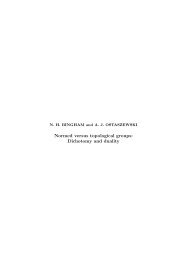Applicable Mathematics in the 18th Century - Department of ...
Applicable Mathematics in the 18th Century - Department of ...
Applicable Mathematics in the 18th Century - Department of ...
You also want an ePaper? Increase the reach of your titles
YUMPU automatically turns print PDFs into web optimized ePapers that Google loves.
No surviv<strong>in</strong>g example <strong>of</strong> Ludlam’s balance has been found, although it is possiblethat one will turn up. Fortunately Ludlam’s own description and his diagram arevery clear. The essential part <strong>of</strong> <strong>the</strong> balance is a beam that forms what is knownas a bent-lever - <strong>in</strong> o<strong>the</strong>r words, at <strong>the</strong> fulcrum <strong>the</strong>re is a non-zero angle (about 12degrees) between <strong>the</strong> two arms <strong>of</strong> <strong>the</strong> beam. In Ludlam’s picture <strong>the</strong> arms are <strong>of</strong>equal length, but he states explicitly that this is not essential. One arm, on <strong>the</strong> left<strong>in</strong> <strong>the</strong> picture, carries a fixed counterpoise, and <strong>the</strong> o<strong>the</strong>r arm carries a variable load,<strong>in</strong> this case a known length <strong>of</strong> yarn. The angle at which <strong>the</strong> beam comes to rest isdeterm<strong>in</strong>ed by <strong>the</strong> mass <strong>of</strong> <strong>the</strong> load, and this angle is <strong>in</strong>dicated by <strong>the</strong> position <strong>of</strong> apo<strong>in</strong>ter on a circular scale. The scale can be graduated <strong>in</strong> any appropriate way, <strong>in</strong>particular to give <strong>the</strong> counts <strong>of</strong> <strong>the</strong> yarn.4. The bent-lever balance before LudlamThe basic ‘laws’ <strong>of</strong> statics, which we tend to take for granted, emerged only graduallyfrom a mist <strong>of</strong> quasi-philosophical speculation. In particular, <strong>the</strong> notion <strong>of</strong>potential energy and <strong>the</strong> pr<strong>in</strong>ciple <strong>of</strong> moments, fundamental to <strong>the</strong> study <strong>of</strong> weigh<strong>in</strong>g<strong>in</strong>struments, were not formulated clearly until <strong>the</strong> later middle ages. The book on<strong>the</strong> Medieval Science <strong>of</strong> Weights by Moody and Claggett [18] is <strong>the</strong> basic source forthis topic. It conta<strong>in</strong>s works by a 13th-century scholar known to us as Jordanus <strong>of</strong>Nemore, <strong>in</strong> which <strong>the</strong> <strong>the</strong>ory <strong>of</strong> weigh<strong>in</strong>g is discussed: <strong>in</strong> particular Jordanus hasseveral results on <strong>the</strong> equilibrium <strong>of</strong> <strong>the</strong> bent-lever balance.The subsequent development <strong>of</strong> all k<strong>in</strong>ds <strong>of</strong> weigh<strong>in</strong>g mach<strong>in</strong>es <strong>in</strong> <strong>the</strong> early modernperiod is described <strong>in</strong> <strong>the</strong> volumes <strong>of</strong> Leupold’s famous Theatrum Staticum [13] <strong>of</strong>1726. Leupold depicted numerous <strong>in</strong>struments, <strong>in</strong>clud<strong>in</strong>g a bent-lever balance, bu<strong>the</strong> gave no <strong>the</strong>oretical discussion <strong>of</strong> <strong>the</strong>ir properties.Accord<strong>in</strong>g to Jenemann [9], <strong>the</strong> first ma<strong>the</strong>matical treatment <strong>of</strong> balances was givenby Euler [7]. His paper was written <strong>in</strong> 1738 and published <strong>in</strong> 1747, and it used <strong>the</strong>pr<strong>in</strong>ciple <strong>of</strong> moments. Among o<strong>the</strong>r th<strong>in</strong>gs, Euler determ<strong>in</strong>ed how <strong>the</strong> beam <strong>of</strong> <strong>the</strong>ord<strong>in</strong>ary equal-arm balance is deflected from equilibrium when a small mass is addedto one <strong>of</strong> <strong>the</strong> arms.The application <strong>of</strong> ma<strong>the</strong>matics to <strong>the</strong> bent-lever balance soon followed. The factthat <strong>the</strong> arms <strong>of</strong> <strong>the</strong> beam have different lengths, and <strong>the</strong> angle between <strong>the</strong>m is notzero, means that <strong>the</strong> <strong>the</strong>ory is more complicated than <strong>in</strong> <strong>the</strong> ord<strong>in</strong>ary case. Bent-leverbalances were discussed by Kuhn [11] <strong>in</strong> 1742 and Lambert [12] <strong>in</strong> 1758. Kuhn seemsto have regarded his <strong>the</strong>ory simply as a modification <strong>of</strong> <strong>the</strong> ord<strong>in</strong>ary one, but Lambertwent fur<strong>the</strong>r and suggested several designs that exploited <strong>the</strong> particular features <strong>of</strong>this k<strong>in</strong>d <strong>of</strong> balance. Of course, <strong>the</strong> ma<strong>in</strong> advantage is that a bent-lever balance isself-<strong>in</strong>dicat<strong>in</strong>g, no ‘loose’ weights be<strong>in</strong>g needed.It is not clear whe<strong>the</strong>r Ludlam himself was aware <strong>of</strong> <strong>the</strong> <strong>the</strong>ory developed by <strong>the</strong>selearned authors. His only reference to earlier work was <strong>the</strong> remark that a certa<strong>in</strong> ‘MrRouse <strong>of</strong> Harborough, many years ago, made a mach<strong>in</strong>e for sort<strong>in</strong>g woollen threadon <strong>the</strong> same pr<strong>in</strong>ciple as this’. The man <strong>in</strong> question was probably Samuel Rouse, anotable citizen <strong>of</strong> Market Harborough <strong>in</strong> <strong>the</strong> mid-<strong>18th</strong> century, who is known to havecorresponded with several local men <strong>of</strong> science [8]. Ludlam says that Rouse’s mach<strong>in</strong>ewas not well-designed for its purpose, because it could not dist<strong>in</strong>guish between yarns<strong>of</strong> <strong>the</strong> f<strong>in</strong>er k<strong>in</strong>d, and that was apparently <strong>the</strong> motivation for his analysis.6
















